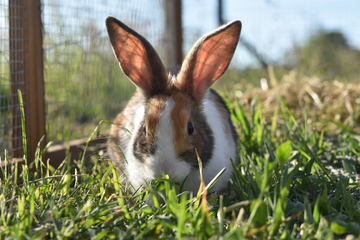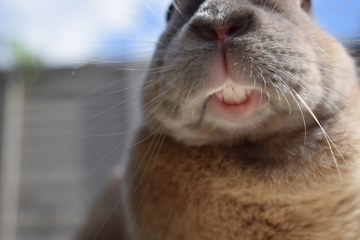Rabbit's Vision: Exploring the World Through Rabbit Eyes
Rabbits, those charming and curious creatures, often leave us pondering about their world. Have you ever pondered what the world looks like through a rabbit's eyes? Join us as we explore the fascinating realm of rabbit vision, from their perception of colors to their adaptations for low-light environments.
Click Here For a Beginners Guide to Rabbit Care.

Attributes and Adaptations of a Rabbit’s Vision
Color Perception
Contrary to popular belief, rabbits do not perceive the world in black and white. Their vision is akin to that of humans, albeit with some intriguing differences. While humans possess three types of color receptors (red, green, and blue), rabbits have only two (blue and green). This means that rabbits have dichromatic vision, allowing them to discern colors within the blue and green spectrum but struggling with distinguishing between red and green hues. So, while your rabbit may appreciate the lush greenery of their surroundings, they might not fully appreciate the vibrant hues of a bouquet of red roses.
Night Vision
Rabbits are crepuscular creatures, meaning they are most active during the twilight hours of dawn and dusk. While they don't possess true night vision like nocturnal animals, such as owls or cats, rabbits have evolved impressive adaptations to thrive in low-light conditions. Their eyes boast a higher concentration of rod cells, specialized photoreceptor cells responsible for detecting light intensity. This adaptation allows rabbits to navigate and forage in dimly lit environments with relative ease, ensuring they can hop around their habitat even as the sun sets.
Red Eyes
Rabbits can have various eye colors, but perhaps one of the most captivating features of some rabbit breeds is their striking red or pink eyes. This phenomenon is attributed to a lack of pigmentation in the iris, allowing the underlying blood vessels to become visible and imparting a reddish hue to the eyes. Breeds such as the New Zealand White, Himalayan, and Albino rabbits commonly exhibit this trait. Despite their eye-catching appearance, rabbits with red eyes do not experience impaired vision. They perceive the world just as clearly as their pigmented-eye counterparts but may be more sensitive to bright light due to the absence of pigmentation to filter out glare.
360-Degree Vision
Rabbit eyes, strategically positioned on the sides of their head, provide them with an impressive panoramic field of view. With almost 360-degree vision, rabbits can monitor their surroundings without the need to turn their heads. This exceptional ability allows them to detect predators approaching from any direction, ensuring they can flee at the first sign of danger. However, rabbits do have a blind spot directly in front of their nose, compensated by their acute sense of smell and whiskers, which help them navigate obstacles in close proximity.
Farsighted Vision
Rabbits exhibit farsighted vision, allowing them to focus more effectively on distant objects while sacrificing clarity up close. This adaptation enhances their ability to detect potential threats from afar, giving them valuable time to react and flee to safety.
Depth Perception Challenges
One trade-off for panoramic vision is reduced depth perception. Unlike humans, who benefit from binocular vision for judging distances and sizes accurately, rabbits rely primarily on monocular vision. Only a small portion of their field of view overlaps, limiting their ability to perceive objects in three dimensions. To compensate for this limitation, rabbits employ a technique called parallaxing, wherein they move their heads back and forth to gauge distances effectively. This adaptive behavior enables them to navigate their surroundings efficiently and detect potential threats with ease.
Rabbit Light Preferences and Other Quirks
Light Preferences
Despite their proficiency in low-light environments, rabbits still prefer well-lit surroundings during the day. Natural sunlight plays a crucial role in regulating their circadian rhythm, behavior, and overall well-being. However, excessive exposure to bright sunlight or harsh artificial lighting can be distressing for rabbits, leading to discomfort or eye strain.
Infrequent Blinking: Eyes Wide Open
In the realm of blinking contests, rabbits reign supreme. Unlike humans, who blink 10 to 20 times per minute, rabbits blink a mere 10 to 12 times in an hour. This infrequent blinking is made possible by a thin membrane known as the third eyelid, which keeps their eyes moist and protected from dust and debris.
By peering deeper into the mysteries of rabbit vision, we gain a deeper appreciation for these remarkable creatures and their unique adaptations. From panoramic sight to exceptional night vision, rabbits possess a visual prowess finely tuned to their survival needs. Understanding the intricacies of rabbit vision helps to improve our care and appreciation for these beloved companions, ensuring their well-being and happiness in our homes.

Rabbit Is It Low Maintenance or More Work Than You Think?

Signs of Rabbit Health: What You Should Know

Decoding Bunny Behavior: Understanding Rabbit Mood




